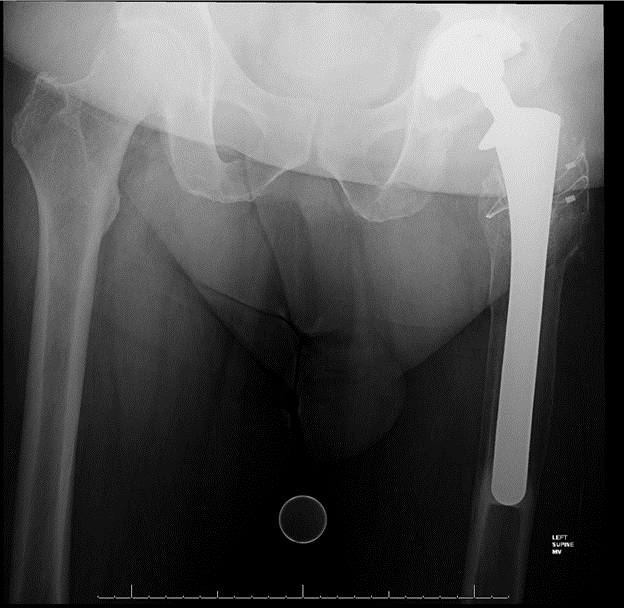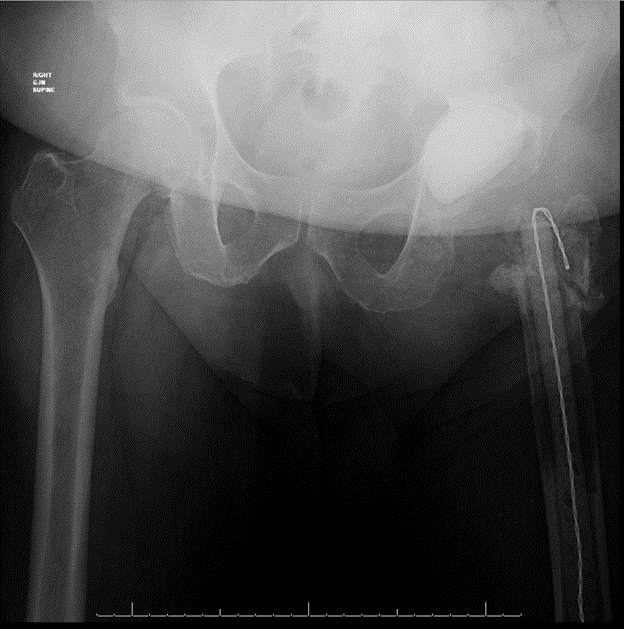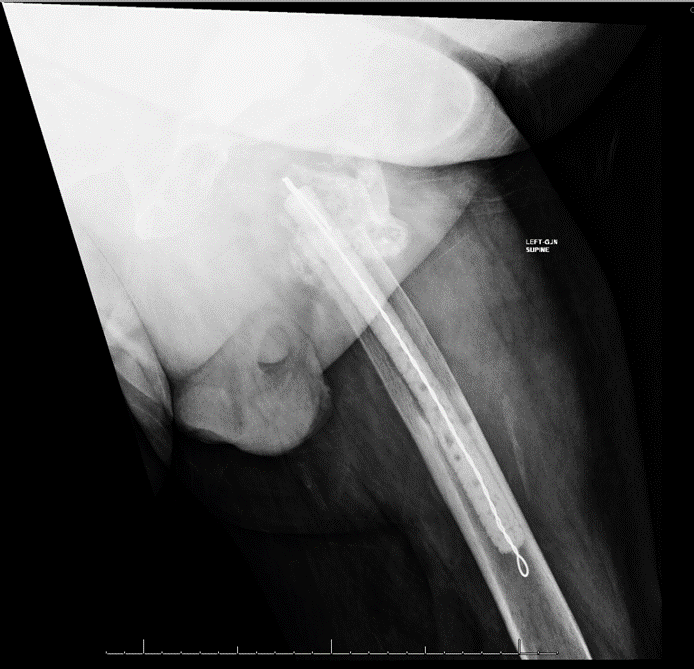Carefully manage the perils of open wounds in prosthetic joint infection treatment
Revision hip and knee surgery poses some unique challenges with a variety of treatment alternatives.
The purpose of this series is to highlight interesting cases that presented to the OrthoCarolina Hip and Knee Center and the OrthoCarolina Periprosthetic Joint Infection Center. This case involves a 57-year-old, 340-pound patient with diabetes 20 years after revision total hip for aseptic loosening.


The patient was lost to follow-up and presented to an outside facility septic with fevers to 103° F and hip pain. Radiographs at that time revealed a cementless acetabular component and a 21-mm extensively coated, long stem in place with severe proximal femoral stress shielding (Figure 1). The patient underwent irrigation and debridement and implant retention (DAIR) at the outside facility. Cultures at the time grew Staphylococcus hominis.

Unfortunately, the wound broke down and a negative pressure dressing was placed on the open part of the wound. After 6 weeks of IV antibiotics and negative pressure open wound management, the patient was referred to our facility for definitive treatment (Figure 2).

At that time, the decision was made to remove all the implants despite the complexity of removing a well-fixed extensively coated, long stem. This was performed by cutting the 21-mm implant below the proximal triangle and then trephining over the distal implant.
Because of the severe proximal femoral bone loss from the infection, as well as stress shielding, an articulating spacer was unable to be placed. Therefore, a static spacer was used (Figure 3). High-dose antibiotics were placed into the static spacer using vancomycin and tobramycin, which should have covered his original organisms.
Postoperatively, the patient did well, however, his cultures grew five different organisms: Staphylococcus epi, Corynebacter, methicillin-sensitive Staphylococcus aureus, Enterococcus and Candida. Therefore, through the use of protracted open wound management, this patient’s monomicrobial original infection now involved five different organisms – one of which was a fungal organism (Candida). Subsequent to the resection, the patient’s wound healed primarily. He was placed on a 6-week course of daptomycin and fluconazole. He was doing well and plans were made to reimplant.


Prior to reimplantation, the patient was given a 2-week drug holiday and his hip was re-aspirated. Unfortunately, he once again grew Candida, as well as a sixth organism, Propionibacterium. Plans for reimplantation have thus been aborted and he is scheduled for re-debridement. This time, we plan on using voriconazole and amphotericin, as well as vancomycin in the cement. Hopefully, this will solve his infection problem. However, what started as a monomicrobial infection has now cultured six different organisms greatly complicating his treatment.
Discussion
Wound dehiscence following irrigation and debridement for acute prosthetic joint infection (PJI) is a difficult management problem. Subsequent wound breakdown following irrigation and debridement is an ominous sign for treatment success. Even when a wound heals primarily, the success of irrigation and debridement for PJI is highly variable. DAIR is dependent on the timing of intervention, organism type and host status.
There exists a degree of emotional investment by patient and surgeon alike to attempt to save the implant at all costs. This case points out the hazards of this well intentioned yet harmful treatment strategy. While negative pressure wound therapy has been shown to be efficacious in hip and knee arthroplasty, it must be understood that such endorsement was done in a few small studies using “incisional” negative pressure wound therapy over closed wounds rather than open wounds with direct communication with the implant as was the case in our patient.
This case points out the hazards of using open wound management, which has the potential of turning a monomicrobial infection into a difficult to treat polymicrobial infection.
Polymicrobial infections
Polymicrobial infections leading to resections have nearly twice the failure rate in two-stage procedures for PJI. Therefore, one of the principals in the treatment of PJI is to close any infected wound to avoid secondary colonization for fear of introducing a polymicrobial infection. Open wound management in the form of frequent dressing changes or vacuum-assisted negative pressure wound therapy have been used in the management of problematic dehisced wounds hoping to stimulate granulation tissue and closure. Unfortunately, open wound management following irrigation and debridement of an infected joint is associated with a high failure rate leading to permanent girdlestone, fistula, amputation or death in 65% of patients in one reported series. An increased number of bacterial strains, as well as difficult-to-treat organisms, were identified. This is similar to what we found in this case.
We have noticed – that not infrequently – patients are referred to the OrthoCarolina Periprosthetic Joint Infection Center with open gaping wounds treated with either frequent wet to dry dressing changes or vacuum-assisted negative pressure wound therapy. In many cases, this treatment has been used for many months without evidence of wound closure. Frequently, these infections that start as a monomicrobial PJI become polymicrobial with resultant worse outcomes following resection and two-stage reimplantation. Additionally, we have noted that many of these chronic wounds are colonized with fungal organisms which are rarely seen in closed wound PJIs.
Take-home message
Debridement and implant retention may have a place in acute PJI. However, if the wound breaks down following this form of treatment, prompt implant removal and primary wound closure is critical for success.
Open wound management following failed irrigation and debridement is inappropriate and leads to difficult to treat multi-organism colonization and less than optimal results.
References:
Fröschen FS, et al. Technol Health Care. 2020;doi:10.3233/THC-192095.
Karlakki SL, et al. Bone Joint Res. 2016;doi:10.1302/2046-3758.58.BJR-2016-0022.R1.
Newman JM, et al. J Arthroplasty. 2019;doi: 10.1016/j.arth.2018.11.017.
Wimmer MD, et al. Int Orthop. 2016;doi:10.1007/s00264-015-2871-y.
